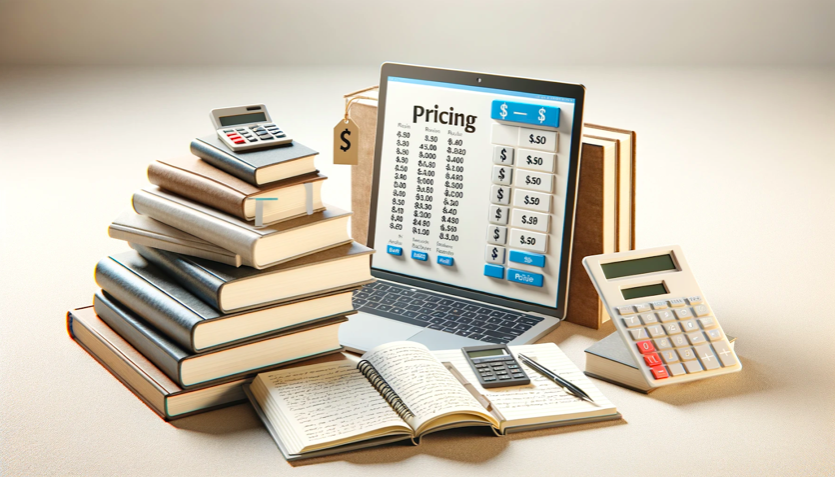Setting the right price for your book is crucial for attracting readers and maximizing sales. Striking the perfect balance involves considering production costs, market demand, and competition. Key concepts in this process include the retail price, the list price set by publishers, and the higher value often held by first editions for collectors.
In this article, we’ll demystify these concepts and offer practical strategies to help you determine the optimal price for your book. Whether you’re a self-published author or working with a publisher, our tips will ensure your book reaches its full market potential and attracts eager readers. Let’s dive into the art of book pricing and set your book up for success!
Understanding Book Pricing
Book pricing refers to the process of determining the amount a customer pays to purchase a book. This price must strike a balance between covering production costs and attracting potential buyers. Several factors influence book prices, including demand, production costs, and market trends. Demand is shaped by the book’s genre, the author’s popularity, and current market interests. Production costs encompass printing, binding, design, and distribution expenses. Market trends, such as seasonal demand and competition from other titles, also play a significant role.
Your Publishing Journey Awaits – Start NowProper pricing is crucial because it directly impacts book sales and profitability. A well-priced book can attract a broader audience, drive higher sales, and increase revenue, while an improperly priced book may deter potential buyers, leading to lost sales and reduced profits. Understanding these dynamics is essential for authors and publishers aiming to maximize their book’s success in the marketplace.
Key Factors to Consider When Pricing Your Book
When pricing your book, it’s essential to analyze your target audience and market. Understanding who your readers are and what they’re willing to pay can significantly influence your pricing strategy. Researching similar books in your genre can provide insights into standard price ranges and market expectations for similar copies.
The format of your book also impacts pricing. Hardcover editions often command higher prices than paperback, due to their durability and perceived value, for example, while paperbacks are typically more affordable and accessible. Ebooks, with lower production and distribution costs, can be priced competitively to attract digital readers. Also depending on whether you choose the traditional printing route or the print-on-demand route.
Additionally, trim size, page count, and publication costs are critical factors. Larger trim sizes and higher page counts increase printing costs, which should be reflected in the book’s price. Analyzing these production expenses ensures you set a price that covers costs while remaining attractive to buyers. By considering these key factors, you can determine a price that balances profitability with market competitiveness.
Comparing Book Prices
Market research is essential when setting the price of your book. By comparing prices, you can position your book competitively within the market. Understanding the pricing landscape helps you gauge what readers are willing to pay and ensures your book stands out among similar titles.
Several tools and resources can aid in this research. Websites like Amazon, BookFinder, and AbeBooks allow you to compare prices for both textbooks and general books. These platforms provide insights into current pricing trends and can help you identify the best price points for your book.
By leveraging these resources, you can gather comprehensive data and make informed pricing decisions that enhance your book’s marketability and profitability.
Steps to Choosing How to Price Your Book
Choosing the right price for your book involves a series of thoughtful steps to ensure you strike a balance between business profitability and market appeal. Here are the key steps to guide you through the process:
1. Research the Market:
Begin your search by researching similar books in your genre and format. Look at bestsellers and average performers to understand the price range. Use platforms like Amazon, Goodreads, and BookFinder to gather data on current market trends.
2. Analyze Your Target Audience:
Identify your target readers and their purchasing behaviors. Consider factors such as age, income level, and reading habits. Understanding your audience helps in setting a price they are willing to pay.
3. Consider Production Costs:
Calculate the total production costs, including editing, cover design, printing, and distribution. Ensure your price covers these expenses while leaving room for profit.
4. Evaluate Book Format:
Different formats warrant different pricing strategies. Hardcovers can be priced higher due to their durability, while a paperback book or an ebook should be more affordable. Consider offering multiple formats to reach a broader audience.
5. Assess the Value of Your Book:
Take into account unique aspects such as the author’s reputation, the book’s content quality, and any additional features (e.g., illustrations, special editions). First editions and signed copies can also be expected to be priced higher due to their collectible nature.
6. Set a Competitive Price:
Based on your research, set a price that is competitive yet profitable. Ensure it aligns with market expectations while reflecting the book’s value.
7. Test and Adjust:
After launching your book, monitor sales and gather feedback. Be prepared to adjust the price if necessary to optimize sales and profitability.
By following these steps, you can confidently set a top sale price that maximizes your book’s market potential while ensuring financial success.
The Role of ISBN and Other Details
The International Standard Book Number (ISBN) is crucial for pricing and selling books. It provides a unique identifier that simplifies cataloging and searching, making your book easily discoverable in online and physical stores. An ISBN boosts your book’s legitimacy, encouraging retailers and libraries to stock it, which can positively impact sales.
Your Publishing Journey Awaits – Start NowDetails like a dust jacket and printing quality also significantly affect a book’s worth. High-quality printing, premium paper, and durable bindings can justify higher prices, as they enhance the book’s overall appeal and durability. Dust jackets, particularly for hardcovers, add an extra layer of protection and aesthetic value, often making the book more attractive to buyers and collectors. By paying attention to these details, you can set a price that reflects your book’s quality and market value, ultimately increasing its appeal and profitability.
Tips for Maximizing Book Sales
Maximizing book sales requires a combination of strategic pricing and effective marketing techniques. Here are some tips to help you attract readers and boost your sales:
1. Engage Your Audience: Use social media, author websites, and newsletters to build a loyal following. Engage with readers through book signings, free online events, and interactive content to create buzz around your book.
2. Offer Promotional Discounts: Temporary price reductions, free chapters, or limited-time offers can entice new readers to purchase your book. Consider running promotions during holidays or special events to increase visibility and sales.
3. Price Strategically for Different Editions: Price first editions and limited editions higher due to their collectible value. For regular editions, ensure your pricing is competitive but still profitable. Offering various editions can cater to different segments of your audience, from casual readers to collectors.
4. Leverage Online Marketplaces and Bookstores: Utilize platforms like Amazon, Barnes & Noble, and independent bookstores to reach a wider audience. Optimize your book’s metadata and keywords to improve search visibility. Encourage reviews and ratings to build credibility and attract more readers.
By combining these techniques, you can effectively attract readers and maximize your book sales, ensuring your work reaches its full market potential.
Mastering the Art of Book Pricing
Setting the right price for your book is a critical step in ensuring its success. We’ve delved into the importance of understanding how to price your book by considering factors such as target audience, book format, production costs, and market trends. Effective market research and competitive comparison are essential for positioning your book.
Engaging your audience and offering promotional discounts can help maximize sales. Leveraging different editions and using online marketplaces can broaden your reach and enhance profitability. Attention to details like the role of the ISBN, dust jackets, and printing quality also contributes to establishing your book’s worth.
In conclusion, finding the best price for your book involves a thoughtful balance of various elements. By applying these strategies, you can set a price that attracts readers while ensuring financial success. Take the time to research, analyze, and adjust as needed to find the optimal price point. With these tools and insights, you’re well-equipped to navigate the complexities of book pricing and achieve your publishing goals.
Your Publishing Journey Awaits – Start Now






